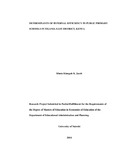| dc.description.abstract | The purpose of the study was to investigate the determinants of internal efficiency
in public primary schools in Tigania East district. Four research questions were
formulated to guide the study. The study adopted a descriptive survey design. The
sample comprised of 10 headteachers, 100 teachers, 10 Education officers and
400 standard seven pupils in the District. Data was collected by use of
questionnaires and were analyzed by use of qualitative and quantitative technique.
Findings revealed that parents’ economic background has a p value of 0.01 which
is lower than 0.05, (significant level) hence was statistically significant in
explaining completion rates. Child labour was statistically significant in
explaining completion rates with a coefficient of 0.169. School physical facilities
had a p value of 0.28 which was higher than 0.05 hence school physical facilities
was not statistically significant in determining completion rates.
Teaching learning resource was statistically significant at a p value of 0.02. Based
on the findings, it was concluded that economic background of parents of children
in primary schools in the area was medium as their source of living was from
miraa farming as indicated by the Education officers. On the influence of physical
facilities on internal efficiency in public primary schools, the study concluded that
pupils did not have adequate sitting place in their class and they sat more than the
required number of pupils in a desk. It was also concluded that pupils whose
schools lacked facilities and materials were significantly more likely to attain
lower scores than those pupils whose schools were well equipped. The study
further concluded that majority of pupils did not have writing materials and there
were no enough textbooks in the class. The schools had inadequate teaching aids,
textbooks, reference materials and staff. The study recommended that the
devolved government should seek ways of empowering the parents economically
so that they are able to provide for the school needs of their children.
The County Government should put up measures to curb child labour such as
involvement in Miraa growing so that pupils can fully participate in learning. The
headteachers and SMC should seek for ways of providing school physical
facilities and teaching learning resources so that effective teaching and learning
can be achieved in schools. The study suggested that since this study was
conducted in one administrative district, there is need to carry out a similar study
in other districts to establish whether similar or different results will be realized.
Taking into consideration that the study was carried out in primary schools, there
is a need to carry out a study in secondary school to assess the factors that
influence internal efficiency. This study focuses on factors such as pupils’ parents
economic background, child labour, school physical facilities and teaching
learning resources. There is a need to carry out a study on how other factors affect
internal efficiency. | en_US |

